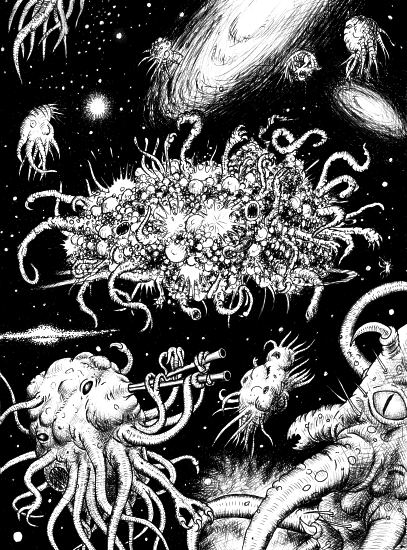Friday, 4 February 2011
Lovecraftian Horror
For most people H. P. Lovecraft (1890-1937) is remembered as the creator of the Cthulhu Mythos. The Mythos assumes that there is another superhuman universe behind what is apparent to us, the shear knowledge of the existence of which is enough to drive a human crazy. Where does the feeling of utter horror come from in Lovecraft's work? I think it is a combination of very ancient fears in the human mind. First take the fear of something greater than us, then add what you think the most ugly creature can look like, and place him on this much greater size and power scale and finally place the control of the universe in the tentacles of such creatures and assume quite correctly that the fate of the human race is of no interest to them. Then imagine that these beings are now sleeping for some reason but they can awaken at any time which would make the fate of humanity questionable. It is the cruelty of the accidental and mechanistically indifferent nature of existence that gains the ugliest forms and causes horror in Lovecraft and his readers. I mean imagine that some creature like the one in the picture would appear in the sky reaching down with its tentacles for something to eat... Better still, imagine that such a creature with the size of a galaxy is sitting in the middle of the universe, the most powerful and hideous creature who is at the same time is blind and is an idiot and you get one of the deities of Lovecraft, Azathoth. Then imagine the opposing entity, an equally powerful but wise and omnipresent creature with similarly hideous form and you get Yog-Sothoth. The Mythos, which Lovecraft called simply Yog-Sothothery, takes its name from its high priest, Cthulhu. Lovecraft created his universe gradually in a series of stories using a Gothic writing style in the process, preferring suspense to downright brutality. For example he refers to an old book called the Necronomicon, which reappears in his stories, but nobody who reads it could reveal its full contents to us since they go mad when they understand it. Lovecraft invited other writers to expand this mythic world, most notably perhaps August Derleth whom I mentioned in an earlier post.
As for film adaptations, I think it is kind of hard to make a movie that captures all the above mentioned features, because either the suspense, or the visual intensity is likely to get lost in the process. Visually, I think some scenes of Guillermo Del Toro's "Hellboy" (2004) grasp the Lovecraftian legacy, but of course this film is more about the comic book hero than about any of Lovecraft's writings. A film that probably best captures the suspense part is a very close adaptation of Lovecraft's probably most well known work, "The Call of Cthulhu" (1926). The story follows the investigation of a hideous statuette leading to a cult of Cthulhu and finally to Cthulhu himself who lies dormant in his city sunk into the ocean until his sleep is disturbed... The film is black-and-white and silent, was directed by Andrew Leman in 2005 and is about 45 minutes long. I think these settings are deliberately chosen to emphasise the atmosphere and to place the minimalist visual approach into fitting context. The result is impressive, though I think there are still plenty of possibilities for further cinematic exploitation.
Subscribe to:
Post Comments (Atom)

No comments:
Post a Comment